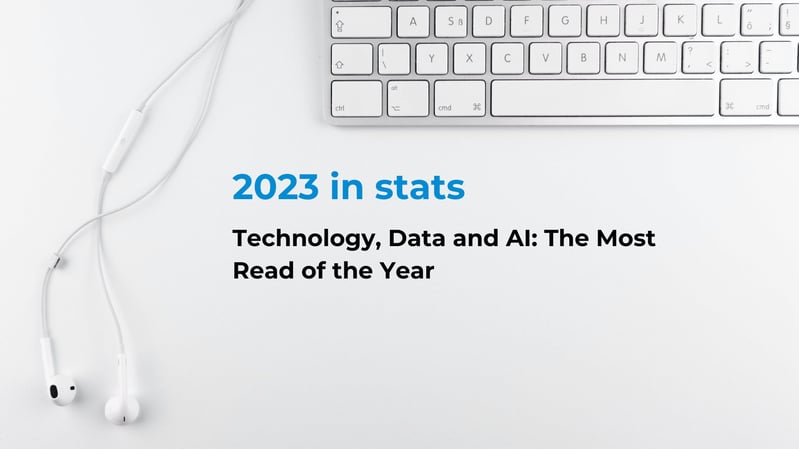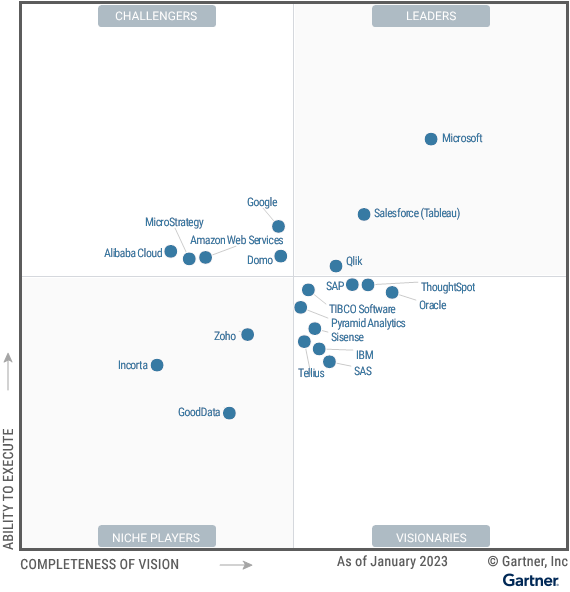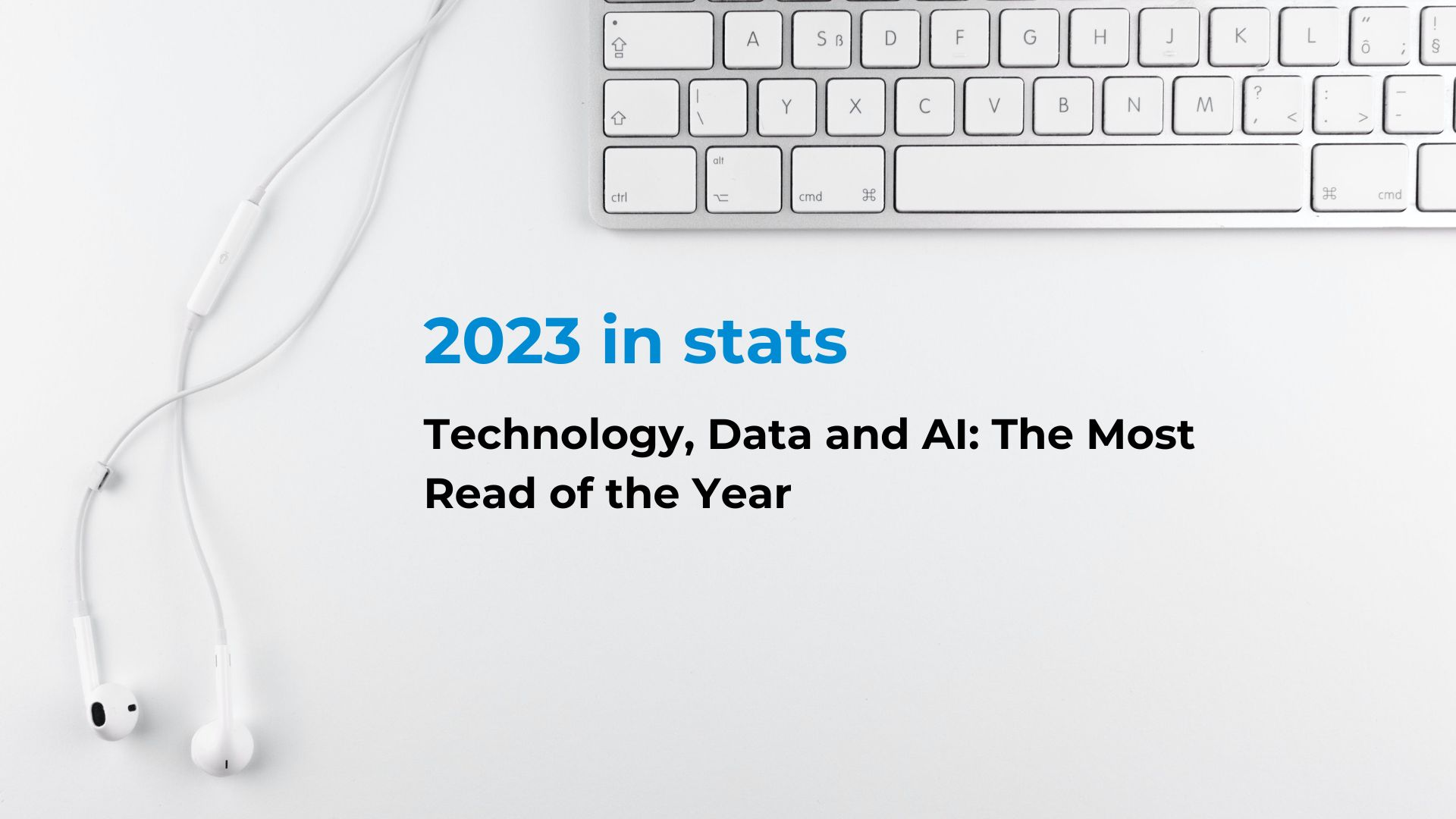We review the most read technology, data and artificial intelligence topics of the year. Don't miss them! We tell you the most read of the year.
With just a few days to go until the end of 2023, we take a look back at the most read technology and data topics of the year. From Power BI to Chat-GPT, 2023 has been a journey through the world of business intelligence, generative artificial intelligence and the best BI tools on the market. Discover the 10 most read blog posts of 2023!

In the exciting technological journey that has been 2023, two names have stood out among the stars of Business Intelligence and Generative AI: Power BI and Chat-GPT. Power BI, Microsoft's leading data analytics platform, continues to establish itself as an indispensable tool for businesses and is recognised by leading international organisations as the market-leading BI platform. Its ability to transform data into information and insights, as well as powerful data visualisations, has revolutionised business decision making.
Undoubtedly, 2023 has been the year of Chat-GPT and generative artificial intelligence, which has captivated everyone with its ability to understand and generate content autonomously.
As we approach the close of 2023, it's the perfect time to dive into the most influential content of the year. From how-to tutorials to in-depth analysis of the latest trends, discover the 10 most-read blog posts that have captured the attention of tech enthusiasts.
A year of consolidation for Business Intelligence:
The year 2023 has seen the expansion and prominence of Business Intelligence (BI). Businesses of all sizes have sought to take full advantage of BI tools to make more informed and strategic decisions. From the growing adoption of platforms such as Power BI to the incorporation of advanced data analytics techniques, business intelligence is no longer simply an option, but an imperative necessity in today's business environment.
The rise of Generative Artificial Intelligence (GAI):
Over the course of 2023, we have witnessed an astonishing breakthrough in the world of technology with the emergence and consolidation of Generative Artificial Intelligence (GAI). This phenomenon has marked a significant milestone in the way we interact with information and how content is generated. A prime example of this progress is Chat-GPT, based on OpenAI's advanced GPT-3.5 architecture. This generative artificial intelligence has fascinated global audiences by demonstrating an astonishing ability to understand and produce text with a level of coherence and naturalness that defies conventional expectations.
The rise of GAI has transcended conventional applications, finding its place in both business and everyday life. From creating creative content to enhancing interaction with virtual assistants, generative artificial intelligence has catalysed a paradigm shift in the way we think about and use technology. As we move into the close of 2023, it is clear that GGI will continue to define new possibilities and challenges, cementing itself as one of the most exciting and disruptive technological developments of our time.
Top 10 most read technology and data blog posts of 2023
1. Azure Synapse and its difference with Azure Databricks
In this article we provide a detailed overview of Azure Synapse Analytics, a service launched by Microsoft in November 2019. It highlights its role as an end-to-end tool that revolutionises big data analytics for large enterprises, consolidating enterprise data warehousing and Big Data analytics. The integration of Azure Synapse with Power BI and Azure Machine Learning provides a unified platform to process, manage and serve data for immediate business intelligence and predictive data needs.
We describe Azure Synapse's unique ability to handle large volumes of information through serverless deployment for ad hoc data exploration and analytics, as well as provisioned resources for scalability. It also highlights its support for multiple programming languages and its integration with Azure Databricks for Big Data processing with Apache Spark.
The Software as a Service (SaaS) approach is highlighted, along with key components such as full T-SQL-based SQL Analytics, fully integrated Apache Spark and connectors to multiple data sources. The ability to run both traditional SQL engines and Spark allows for significant flexibility in data processing, adapting to various engineering needs and profiles.
Read the full article here:
2. What is an insight? Key examples of marketing insights
The article discusses the concept of "insight", which is crucial in fields such as marketing, communication, business intelligence and data analysis. Despite its importance, many executives are unaware of its exact meaning. Insight, derived from English and with multiple connotations, refers to knowledge that adds value and enables the creation or improvement of something in the business environment.
In business, insights are fundamental to business strategies, especially in marketing and advertising. These key insights come from research and, nowadays, mainly from data analysis. It is essential to understand that a piece of data is not an insight; it is gained through data analysis, contextualisation and transformation, thus driving data-driven transformation processes.
Insights are vital for defining strategies, making decisions and executing actions in business. In marketing, they come primarily from customer data and are used to create campaigns, personalised content and experiences that meet customer needs. These insights are also essential for optimising operations and developing customer-centric strategies.
The article provides outstanding examples of insights-driven marketing campaigns, demonstrating that knowledge drives innovative ideas in this field. Each of these campaigns exemplifies how a marketing insight can drive creative and effective strategies to connect with consumers in a meaningful way.
Discover the examples of marketing insights in the full article:
3. Microsoft Power BI, leader of Gartner's Magic Quadrant 2023
In the latest Gartner Magic Quadrant for Business Intelligence and Analytics Platforms (ABI) 2023, Microsoft Power BI has again been recognised as the leading platform. Gartner praises Power BI's integration and joint vision with Microsoft 365, Teams and Azure Synapse, as well as its breadth of capabilities and competitive price-performance ratio.

Overall, Gartner highlights Power BI's dominant market position thanks to its reach and integration with other Microsoft platforms. It also highlights pricing flexibility, superior functionality and the product's ambitious roadmap as plus points.
However, Gartner points to difficulties with data governance as a weakness of Power BI. In response to these shortcomings, Bismart, as a Microsoft Power BI Preferred Partner, has developed a specific data governance solution for Power BI, enabling companies to tailor the Power BI environment to their data governance policies.
The Gartner Magic Quadrant is a graphical representation that evaluates and ranks the world's leading technology vendors. Gartner highlights that Microsoft is positioned as a leader due to the unique capabilities of Power BI and its integration with Microsoft 365, Azure and Teams.
The report highlights key trends in the BI and analytics platform market, focusing on the ability to meet the strategic needs of business users. It also highlights the importance of improving data governance and the demand for open and unconstrained architectures in the process of creating and disseminating analytics content.
The article provides a detailed overview of the critical capabilities of Business Intelligence and Analytics platforms according to Gartner, and highlights specific strengths and weaknesses of Microsoft Power BI as assessed by Gartner. Overall, it reaffirms Power BI's leadership position in the market, recognising its strengths and providing suggestions for addressing its areas of improvement.
View the Gartner Magic Quadrant 2023 in the full article:
4. Chat GPT 4: What is it?
Chat GPT-4, OpenAI's new artificial intelligence chatbot, was released on Tuesday 14 March as an upgrade to its previous version, Chat GPT-3.5. According to OpenAI, GPT-4 is faster, more self-sufficient, creative and stable than its predecessor. This multimodal model uses artificial intelligence and natural language processing to respond in natural language, write code, translate, correct text, among other capabilities.
Chat GPT-4's capabilities include improvements in creativity, visual input and breadth of context. It can now process up to 25,000 words of user text, interact with web links and process images. OpenAI notes that GPT-4 is safer, with 40% more objective responses and 82% less likely to respond to impermissible content.
.The use of GPT-4 Chat is initially available in the paid ChatGPT Plus subscription and as an API for developers. Microsoft already uses GPT-4 in its Bing Chat browser. Although GPT-4 presents advances, OpenAI recognises limitations, such as social biases, hallucinations and inaccurate responses.
Compared to GPT-3.5 Chat, GPT-4 understands more nuanced instructions, is more intelligent, less error-prone and more resistant to inappropriate requests. In addition, GPT-4 introduces new capabilities, such as understanding images, improving scheduling, passing tests and understanding humour. Despite these improvements, OpenAI admits that GPT-4 is not perfect and still has limitations.
5. The Excel integration with Chat GPT that could change everything
Although Excel was not initially conceived as a BI tool, many companies, especially those less advanced in data strategy, continue to use Excel as their primary data integration, analysis and data visualisation tool. The article highlights that, despite more advanced options on the market, some companies still prefer the familiarity and accessibility of Excel.
Even in business intelligence, data analysts continue to use Excel because of its flexibility and ease of use. Forbes data indicates that 62% of data analysts exploring data sets use Excel. Even those more technical, such as those working with SQL, continue to use Excel in their data exploration processes.
The article discusses the possible future evolution of Excel and highlights the partnership between Microsoft and OpenAI, suggesting that artificial intelligence capabilities, including the use of ChatGPT, could be integrated into Excel. This integration could enhance Excel's functionality, allowing users to analyse data directly in Excel spreadsheets using natural language instructions.
In conclusion, the integration of ChatGPT with Excel looks like a significant potential advantage for Microsoft, taking Excel's popularity to the next level and contributing to the growth of Power BI, which is already recognised as a leader in the BI and analytics market, according to Gartner.
Incluso en el ámbito de la business intelligence, los analistas de datos siguen utilizando Excel debido a su flexibilidad y facilidad de uso. Datos de Forbes indican que el 62% de los analistas de datos que exploran conjuntos de datos utilizan Excel. Incluso aquellos más técnicos, como los que trabajan con SQL, continúan utilizando Excel en sus procesos de exploración de datos.
6. Top 15 Power BI Dashboards of the year
El texto destaca el papel fundamental de Power BI en la creación de cuadros de mando o dashboards para supervisar y analizar el rendimiento empresarial. Estos cuadros de mando son esenciales para transformar datos en información a través de la visualización y el storytelling, con el objetivo de guiar a los ejecutivos en la toma de decisiones basadas en datos.
The text highlights the fundamental role of Power BI in the creation of dashboards to monitor and analyse business performance. These dashboards are essential for transforming data into information through visualisation and storytelling to guide executives in making data-driven decisions.
Business intelligence experts have identified the top 15 Power BI Dashboards of 2023, which include:
- Balanced Scorecard (BSC)
- Financial Dashboard
- Cost optimisation Dashboard
- Marketing Insights Dashboard
- Sales Scorecard
- Customer Segmentation Dashboard
- Customer Portfolio Profitability Dashboard
- Customer Journey Dashboard
- Social Media Insights Dashboard
- Hotel Management Dashboard
- Cross-Selling and Up-Selling Scorecard
- Human Resources Dashboard
- Power BI Viewer, Power BI Analytics and Power BI Data Catalog
Each of these dashboards addresses specific areas, from financial management to customer segmentation, social media analytics, hotel management and more. In addition, the role of specific tools such as Zebra BI for visualising financial data in Power BI is highlighted.
Finally, three dashboard environments designed to improve productivity, asset management and promote security within Power BI are presented: Power BI Viewer, Power BI Analytics and Power BI Data Catalog. These tools focus on facilitating collaboration, data analysis and security in the use of Power BI.
Read the full article here:
7. Introducing Microsoft Fabric
On 23 May, Microsoft introduced two new capabilities for Power BI: Microsoft Fabric and Copilot. Microsoft Fabric aims to create a flexible data architecture around Power BI, while Copilot provides advanced artificial intelligence capabilities based on machine learning and natural language processing.
Microsoft Fabric integrates Data Factory, Synapse Data Engineering, Synapse Data Warehouse, Synapse Data Science and Synapse Real-Time Analytics into a SaaS solution centralised in a data lake. It also introduces concepts such as OneLake, which integrates all data lakes, and Direct Lake, a model for loading data into Power BI.
While Microsoft Fabric promises to transform the way people work with data, Power BI users do not need to change their current approach. The platform will continue to work as before, with access to new capabilities for Power BI Premium users.
Copilot, the new artificial intelligence project, allows users to ask questions about data and create visuals and DAX measures through descriptions. It optimises data exploration by generating automatic summaries.
In short, Microsoft Fabric and Copilot promise to enhance the Power BI user experience by offering a more integrated platform and advanced AI capabilities.
Read the full article here:
8. Microsoft Azure is the leading data integration platform according to Gartner
The latest Gartner Magic Quadrant for Integration Platforms as a Service (iPaaS) 2023 highlights Microsoft as a leader alongside Oracle, Workato and SAP. The leadership position is attributed to the extensive integration capabilities of the Azure ecosystem.
iPaaS are cloud services that enable end users to implement integrations between various applications, services and data sources. Their utility focuses on maintaining consistency between data assets, automating business processes and workflows, and creating exposed services such as APIs or events.
Gartner sets out six minimum requirements for iPaaS platforms, including being a cloud service, being fully managed by the provider and enabling use cases such as data consistency, multi-step processes and composite services.
Microsoft Azure leads the quadrant with Azure Integration Services, which includes tools such as Logic Apps, API Management, Service Bus, Event Grid, Functions and Data Factory. It highlights transformation in the technology sector, collaborative innovation and responsiveness to market demands.
Take a look at the complete Gartner's Magic Quadrant here:
9. The Spanish hotel industry in statistics
This article compiles the most significant data for the Spanish hotel sector in 2023. Out of the most pronounced trends, the following stand out:
-
Tourism growth: Both domestic and international tourism have experienced remarkable growth in 2022, despite rising accommodation prices.
-
Tourist spending: In the first half of 2022, both Spanish and international tourists spent almost as much as in 2019, marking an economic recovery.
-
Market share of Spanish hotel chains: The market share of Spanish hotel groups has grown and is close to 73% in 2023, indicating a solid recovery.
-
Tourism GDP: During the third quarter of 2022, tourism GDP exceeded pre-pandemic levels, with an increase of 2.7% compared to the previous year.
-
Hotel occupancy: The hotel occupancy rate increased by 70.8% in 2022, although it still does not reach 2019 levels.
-
Growth of the accommodation stock: The Spanish accommodation stock grew by 1.7% in the last year, with more than 4,584 establishments and 600,159 rooms in 2023.
-
Trend towards franchising and light management: Although the majority of establishments are owned or rented, there is a growing trend towards franchising and light management models, representing 16.04% in 2023.
-
Increase in luxury accommodation and amenities: There is an increase in the supply of higher amenity accommodation, linked to luxury and holistic experiences.
-
Growth in openings: Although slightly lower than 2021, the sector experienced 114 openings in 2022, adding 8,141 rooms to the Spanish accommodation stock.
-
New operators and experience-based brands: The arrival of new operators such as 'UMusic Hotels', 'Beaumier' and the 'Zel' brand demonstrates the growth of establishments focused on experiences beyond traditional hospitality.
Overall, these data confirm the solid recovery and continued growth of the Spanish hotel sector in 2023.
For more specific details, you can download the full report here:
10. How to use AI in a hotel
Artificial intelligence (AI) is transforming the hospitality industry, offering many opportunities to improve operational efficiency and the customer experience.
In this article, we explore six ways in which hotel chains can apply AI:
-
Occupancy Prediction: Using predictive analytics algorithms to predict occupancy, enabling optimisation of resources and personnel.
-
Operations and Maintenance Management: AI is applied in staff scheduling, energy management, predictive maintenance and management error detection.
-
Dynamic Pricing Policy: Predictive analytics to establish pricing strategies based on competition and forecast demand, optimising purchases and predicting inflation.
-
Customer Service Chatbots: Implementation of AI-powered chatbots to provide 24/7 assistance, automate bookings, process payments and offer post-stay support.
-
Sentiment Analysis: Using natural language processing to analyse customer opinions, monitor brand reputation and detect trends in public opinion.
-
Customer Experience Personalisation: AI can be used for personalised recommendations and the use of facial and voice recognition to deliver a more individualised experience.
AI stands out as a key technology for hotel chains in a competitive business environment, offering advantages in both optimising internal operations and personalising the guest experience.
Read the full article here:
In short, these were the technology, business intelligence and artificial intelligence topics that most interested readers and technology experts this year.
Clearly, in the field of technology, this year has been dominated by continued advances in artificial intelligence, machine learning and cloud computing. In the area of data and business intelligence, the importance of data-driven decision making and advanced analytics has been a major focus. The efficient management of large data sets, the rise of data visualisation tools and the emphasis on privacy and security also stand out as important themes. On the other hand, advances in language models, such as GPT-4 or its equivalents, have generated great interest, placing the practical applications of artificial intelligence in sectors such as healthcare, finance and automotive, as prominent trends.





